If you were looking for a yellow succulent plant for your collection, Sedum Makinoi Ogon is the best fit.
Not only that but also, they would be a perfect fit for your hanging baskets and pots.
Sedum Makinoi Ogon are hardy succulents as they could thrive well even though they do not get the right growing conditions as well. They are used to grow in hot, dry drought weather conditions.
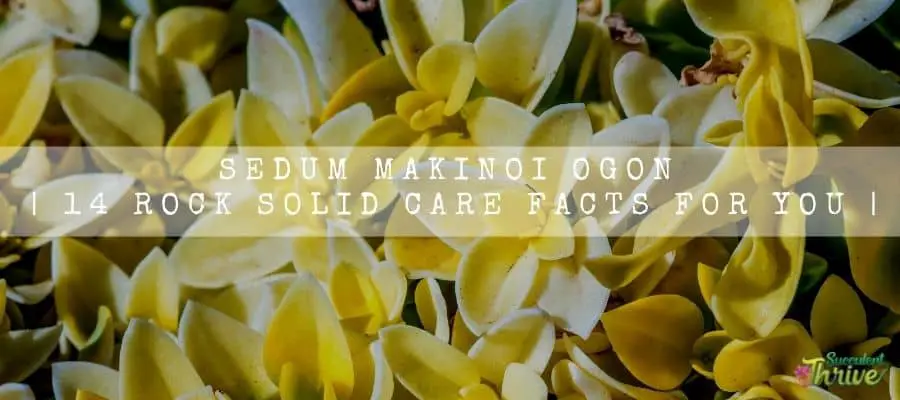
What is Sedum Makinoi ‘Ogon’?
Sedum Makinoi Ogon is a perennial succulent. You could call them the golden Japanese Stonecrop, in common.
This is a quite famous sedum variety which many people use for ground covers. They tend to remain as compact plants.
Moreover, Sedum Makinoi Ogon form in a mat forming manner as well. They also have evergreen foliage.
Sedum Makinoi Ogon requires easy maintenance from you and even a beginner in succulent gardening could start gardening them.
Furthermore, Sedum Makinoi Ogon is a cultivar of Sedum Makinoi.
Sedum Makinoi Ogon are native plants in South America and in Africa. They belong to the Crussalaceae family.
They have inherited the nickname stonecrops as they could thrive well no matter, they get the proper care or not. Sedum Makinoi Ogon could live longer than most of the succulents.
How do I identify Sedum Makinoi ‘Ogon’?
You could identify the Sedum Makinoi Ogon from round shaped leaves in golden yellow to green colors.
Those leaves would arise from trailing stems. Sedum Makinoi Ogon leaves are tiny, fleshy and form in rosette types.
Those leaves will grow in a parallel manner on to the ground. Hence why many people tend to grow them as ground covers
That makes them look very graceful. When they are exposed to cool temperatures, their leaves’ color would be enhanced.
In addition to aforesaid factors, you could identify them from their flowering also. Sedum Makinoi Ogon usually produces flowers in yellow.
They would be star shaped and you could spot them flowering in spring and in summer. Sedum Makinoi Ogon flowers usually form in clusters.
However, Sedum Makinoi Ogon is better known for its attractive foliage than their flowering.
Size of the plant
Sedum Makinoi Ogon’s maximum height would be 5 cm (2 inches) and 30 cm (12 inches) in width. On the other hand, their leaves would be 8 mm in width.
Growth rate
Sedum Makinoi Ogon usually has a moderate growth rate.
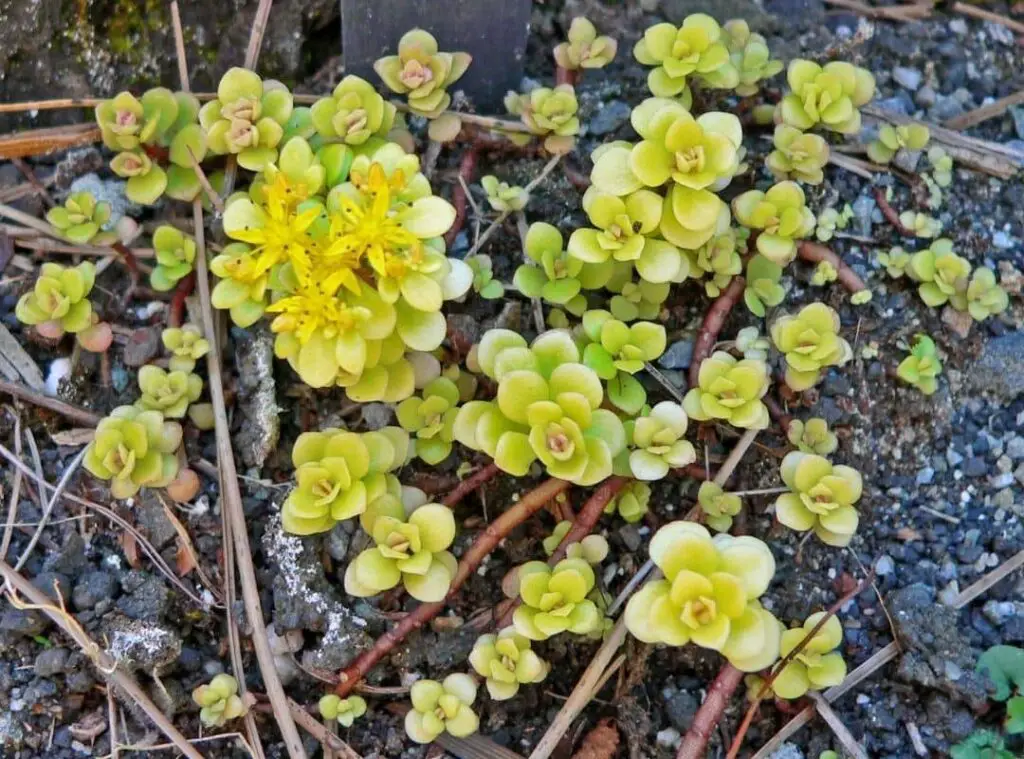
One look care guide
| Botanical Name | Sedum Makinoi Ogon |
| Common Name | Golden Japanese Stonecrop, Ogon Sedum |
| Plant Type | Succulent |
| Mature Size | Maximum height would be 5 cm (2 inches). Maximum width would be 8 mm. |
| Sun Exposure | Full sunlight to partial sunlight |
| Soil Type | Well-draining, |
| Soil pH | Alkaline or neutral |
| Bloom Time | spring and in summer |
| Flower Color | Yellow |
| Hardiness Zones | USDA hardiness zones 6a-9b. |
| Native Area | South America and in Africa |
| Toxicity | Nontoxic |
| Average price | 10 USD |
How do you take care of Sedum Makinoi ‘Ogon’?
Light Requirement
Sedum Makinoi Ogon could thrive well in strong sunlight levels. However what would suit them the best would be full sunlight in the morning and partial sunlight in the intense afternoon hours.
As such you could ideally grow them as perfect ground covers. Moreover you could grow them in pots or in hanging baskets and keep them exposed for sufficient sunlight.
Possibly the best thing you could do is to grow them closer to a bright sunny window where they can gain at least 6 hours of bright sunlight.
Alternatively, you could grow them near an artificial light. Sedum Makinoi Ogon are robust plants which means they can tolerate frost conditions as well as the heat conditions for a short period of time.
Sedum Makinoi Ogon could survive in low lighting conditions too. If you keep growing them under low lighting levels, that will lead the plants to become lime green in color.
Temperature and humidity
Sedum Makinoi Ogon would grow well in temperature ranges around 65 degrees Fahrenheit – 75 degrees Fahrenheit (18 degrees Celsius – 25 degrees Celsius) particularly during summer.
On the other hand, the best temperatures for them to grow during winter would be 50 degrees Fahrenheit – 55 degrees Fahrenheit ( 10 degrees Celsius – 12.7 degrees Celsius).
As with the other succulents, avoid leaving them under frost conditions as it could be unhealthy for the plants.
In terms of the right humidity levels, they would grow well and vigorously given that they can gain dry to average humidity levels. However, ensure that they are grown in a well-draining soil mix though.
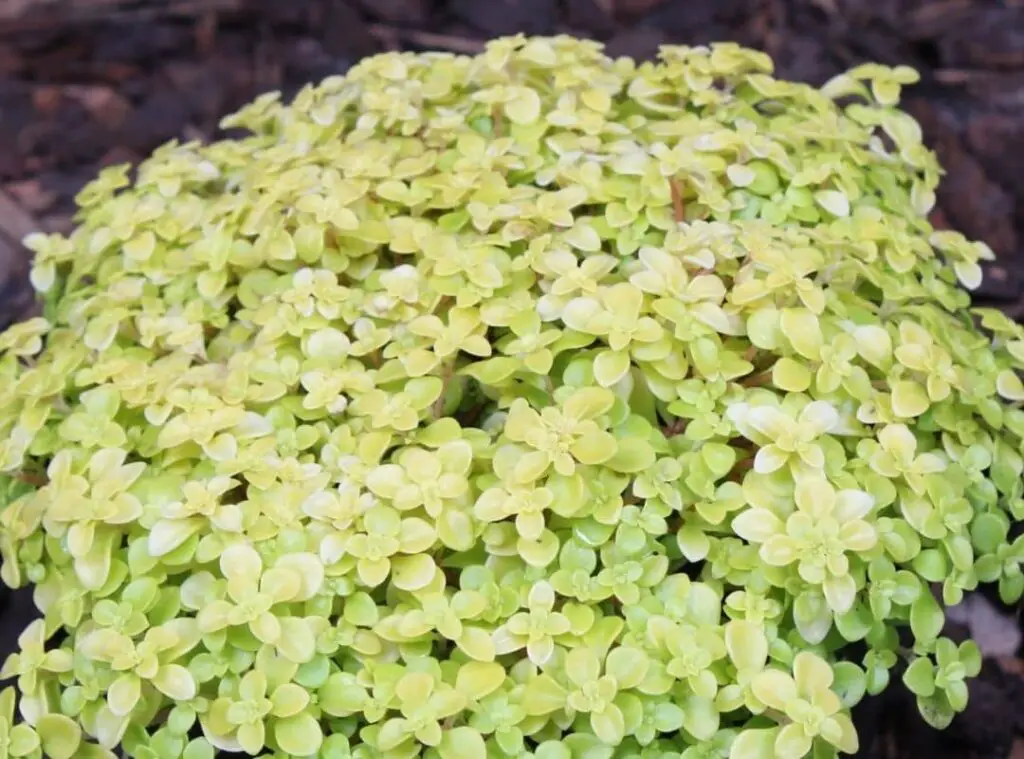
Is it cold hardy?
Sedum Makinoi Ogon are cold hardy up to 10 degrees Fahrenheit.
USDA Hardiness Zone
Sedum Makinoi Ogon are hardy in USDA hardiness zones 6a-9b.
Watering Requirement
Sedum Makinoi Ogon plants have typical watering requirements just like the other succulents. Literally you do not have to water them frequently. Instead, water them thoroughly.
Having said that you could water them once a week or once every fortnight during spring and summer given that their soil is dry.
On the other hand, you can reduce watering to once every two weeks given that you check the soil condition.
Keep in mind that you need to water the potted plants more than what you do with the plants in the garden.
Just like with the other succulent, you should ascertain whether the soil is dry from the previous watering session.
Soil Requirement Type / pH
Succulents have special requirements when it comes to their soil mix as they cannot thrive well in the regular soil mix.
In fact, it is essential that you provide them with a soil mix which is well draining and Sedum Makinoi Ogon is not different from them.
They also require a soil mix which has excellent drainage.
You could make a right soil mix by blending potting mix and perlite in balanced amounts. Further you could consider adding worm castings which will add more nutrition to your soil mix.
You could consider adding perlite instead of coarse sand as that will be beneficial in improving the aeration of the soil mix. Ideal pH of the soil mix should be alkaline or neutral.
Flowering and Fragrance
Sedum Makinoi Ogon produces flowers in yellow. Generally, their flowering season falls in Summer. Sedum Makinoi Ogon blooms would tend to take a star shape.
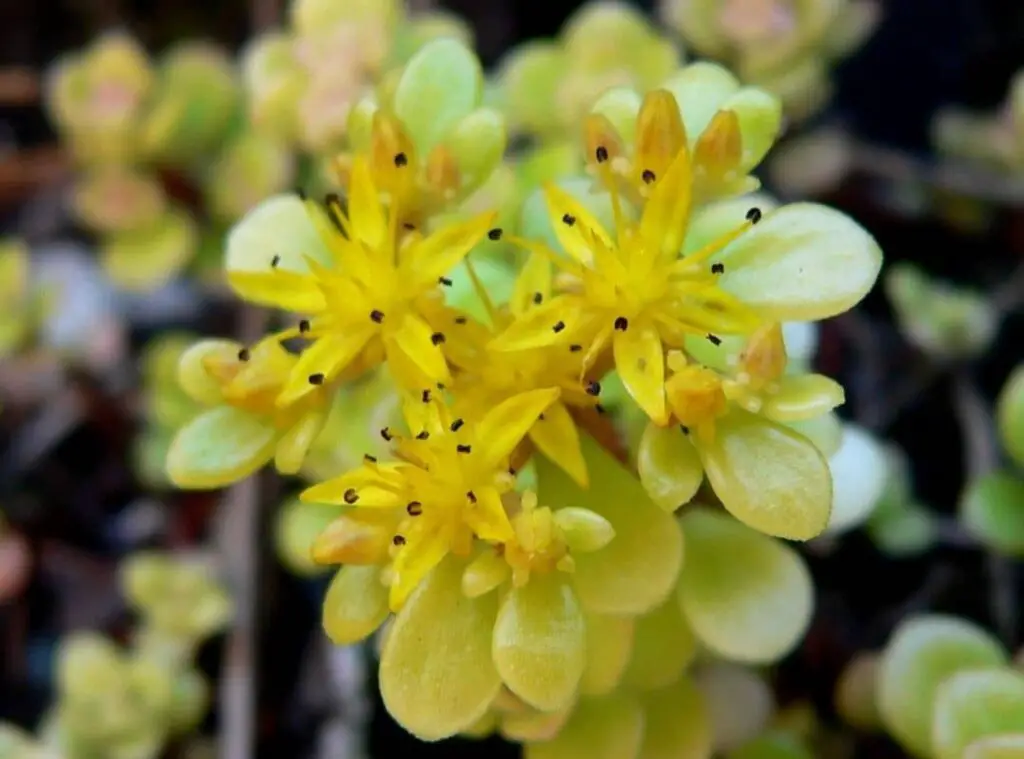
Pot size Potting and Repotting
Terracotta pots or clay pots would be perfect materials to grow the Sedum Makinoi Ogon plants. They are compact plants, and you should not go for larger pots.
Having said that, when the plants keep growing you need to shift them to a wider pot. That will make sure that the new roots have adequate space to spread out and grow firmly.
When it comes to repotting, you may do it once every two years. Keep in mind that you are using a well-draining soil mix.
You could practice the general repotting steps when repotting the Sedum Makinoi Ogon as well.
Where to Plant
As explained in the beginning of the article, Sedum Makinoi Ogon could thrive well even in less hospitable areas.
Having said that, Sedum Makinoi Ogon would prefer to grow in moderately fertile, well-draining soil mix.
You need to ideally select a place where they are exposed to partial shade during the afternoon, particularly during intense summer conditions.
They are cold hardy up to 10 degrees Fahrenheit. However, if there are extreme weather conditions, you need to take necessary steps to protect them from such conditions.
Fertilizer and time of year
Sedum Makinoi Ogon are not heavily dependent on fertilizers. Having said that, you could consider adding a diluted liquid fertilizer if you wish to feed them.
Instead of it, you may also use a slow releasing nitrogen fertilizer during spring and summer. Moreover, you could consider adding compost or worm castings as well.
Dormancy
Sedum Makinoi Ogon would go into dormancy during winter particularly if the temperature drops to 10 degrees Celsius.
As such you need to bring them indoors if you have grown them in potted plants outdoors. I do not recommend doing any repotting or feeding when they are dormant.
Can be toxic to pets
Sedum Makinoi Ogon are not regarded as toxic plants for pets. As such you could grow them along with your furry friends.
Common bugs and illnesses
Sedum plants could resist pests and diseases in general. Having said that, you need to watch out for specific pests such as mealybugs, aphids, vine weevils etc.
Apart from that they could go through diseases such as root rot as well. Sedum Makinoi Ogon which are grown outdoors may come across snail attacks.
In addition to snails, slugs and caterpillars may invade these plants.
To remedy them, you could use insecticides. If not, you may also use neem oil in the evenings. Applying neem oil is one of the best prevention methods of these pests.
On the other hand, high humidity levels could make the plants more prone towards rot. Hence why you need to make sure that you are growing them in a well-draining soil mix and refrain in supplying water in abundance.
Special Care tips
As I mentioned in the beginning of the article, Sedum Makinoi Ogon could thrive well even in less hospitable areas.
Having said you should ensure that they get all their right growing conditions fulfilled too. Moreover, you may consider pruning them if you spot your Sedum Makinoi Ogon growing wild.
Further you could cut back the dead flowers so that it would be helpful for you to maintain a neat and tidy look of the plants.
Apart from that you may consider repotting them particularly during spring. You need to repot them if you see them outgrown from the pots.
When repotting these plants, ensure that you do it with safety unless you could harm the roots of the plants since they are fragile.
Last but not least, you need to take necessary steps to safeguard these plants from extreme winter conditions.
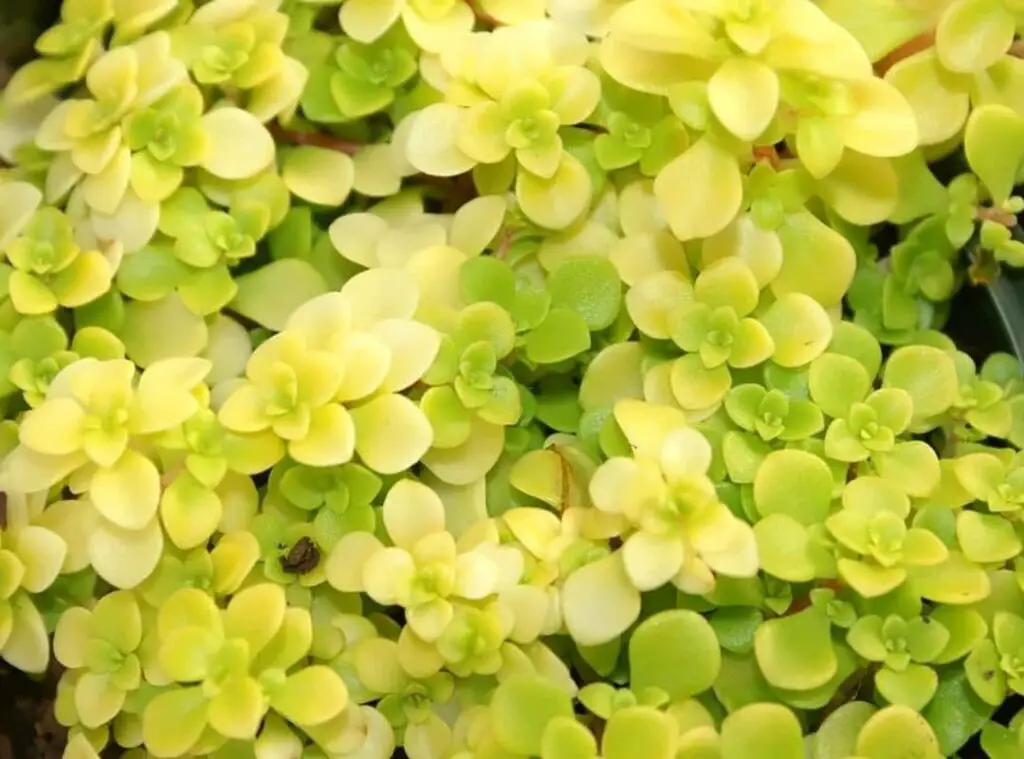
How to propagate Sedum Makinoi ‘Ogon’
You could use either stem cuttings or leaf cuttings to propagate Sedum Makinoi Ogon plants. However, I encourage doing the propagation during spring or in summer.
You could simply break off the stems and plant them in whatever the place you wish to grow them. They could form roots very easily.
It is not recommended to propagate these plants by using their seeds as it is a slow process, and it is very unlikely that it will succeed. You could use either soil or water as their propagation medium.
If you wish to propagate the Sedum Makinoi Ogon by using the leaf or stem cuttings, you first need to obtain a healthy leaf or stem cuttings.
Next you may place them in water or in soil. You could spot them forming roots within a couple of weeks. Next you may transfer them into pots in which you have filled with a succulent soil mix.
You could see them developing their roots within a few weeks’ time.
Sedum Makinoi ‘Ogon’ plant benefits
Sedum Makinoi Ogon are beneficial in many ways. You could use them as ground covers. In addition to that you could grow them in rock gardens, flagstone paths, rock walls also.
Apart from that you could grow them in hanging baskets and grow them as hanging plants.
Further you may use them in the pavement pathways also
Conclusion
Before wrapping this up to sum up the things we discussed in the above article, Sedum Makinoi Ogon are hardy and very attractive plants which could thrive in less hospitable growing conditions.
They could be handy for freshers in gardening as well. So, hurry up, grab your Sedum Makinoi Ogon plant and enjoy growing them.
Read Next : Sedum Sunsparkler Angelina’s Teacup | 14 Amazing Care Tips |
